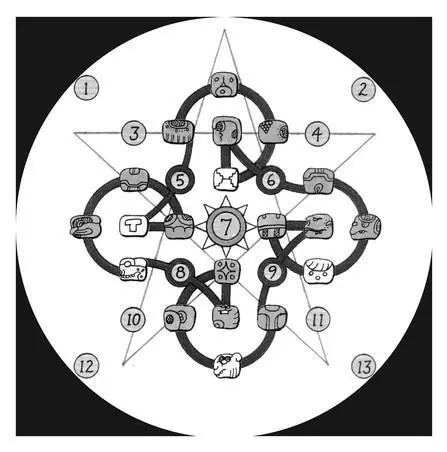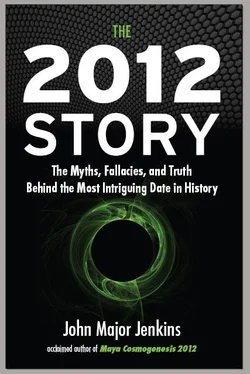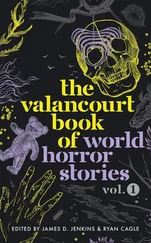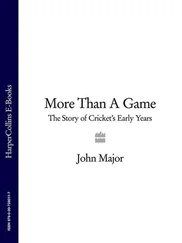
The 13 numbers and 20 day-signs in a mandala. Drawing by the author
Individual renewal and world renewal must happen in concert. Both share the same representative image: the mandala —the image of center, source, wholeness, oneness. To the extent that the world image is a projected dream of the inner psyche, the burden of successful world renewal lies with the individual. We decide, and we make it or break it. We may prefer to sit around, “waiting for 2012 to happen,” and avoid the responsibility for being the change that needs to happen, but that completely misses the point. If we don’t do it before the 2012 party, it will be waiting for us afterward.
And now the rope of time runs out unweaving the wrongs
Till nothing’s left but loosening strings and without doubt all the things
Dissolve into the sea of songs 4
—John Major Jenkins
APPENDIX ONE
GLOSSARY OF TERMS
1 Ahau.The Sacred Day of Venus. Occurs every 104 haab (26 days less than 104 years) when the cycles of Venus, the tzolkin, and the haab coordinate on a Venus morning star rising.
4 Ahau.The day in the 260-day tzolkin calendar that coordinates with both the zero day and the completion day of the 13-Baktun cycle.
Ahau.One of the 20 day-signs in the 260-day tzolkin calendar. Has multiple meanings, including “solar lord” and “blowgunner.”
Anagogical.Perceiving or accepting that symbols have a higher or larger reference to other sets of meanings, beyond a literal and specific denotative meaning. The etymology of the term means “upward-leading.”
Anagogue.A neologism derived from the term anagogical (see entry). By analogy with the relationship between pedagogical and pedagogue , an anagogue is a person who teaches or believes in the anagogical interpretation of symbols.
Apocalypse.From the Greek, ‘Aποκα′λυψις ( Apokálypsis ), meaning “lifting of the veil” or “revelation.” In modern usage it has become synonymous with a fated catastrophe.
Apocatastasis.From the Greek, meaning the restoration of the original and true conditions. Implies a doctrine of degeneration through time followed by regeneration, which may apply to the world generally or to conditions within humanity, including spiritual awareness.
Astro-theological.A worldview espoused in many ancient cultures, including the Greek and Maya civilizations, founded on an intimate relation between the human world, spiritual teachings, and astronomical cycles. It often resulted in the alignment of temples with meaningful astronomical horizons. See, for example, The Earth, The Temple, and the Gods by Vincent Scully, Jr.
Baktunian movement.A term used by Maya scholar Victor Montejo in reference to the modern renaissance of Maya culture heralded by a renewal at the end of the Baktun (in 2012).
Bloodletting rites.A sacrificial practice of letting blood from the tongue, earlobes, or penis by ancient Maya elite.
Buddhi, buddhi mind.Buddhi is a feminine Sanskrit noun derived from the same root as Buddha ( budh —to be awake; to understand; to know). The word signifies a transpersonal faculty of mind higher than the rational discursive mind that is approximately equivalent to “intuitive intelligence” or “higher mind,” but is more properly identified as gnosis (direct inner knowing). It is “that which knows”—that is, able to discern truth from falsehood.*
Calendar Round.A period of 52 haab (18,980 days) representing the synchronization of the 260-day tzolkin and the 365-day haab.
Chac Mool.A reclining deity holding a bowl in its belly to receive sacrificial offerings. Associated with the New Fire ceremony and the movement of the Pleiades. Many large and small stone carvings of Chac Mools have been found.
Classic Period.The period of the Maya florescence and sudden decline, from 200 AD to 900 AD. The beginning of the Classic Period used to be set at 300 AD, but defining characteristics have now been identified for an earlier date.
Correlation.The coordination of the Maya time system with the modern Gregorian calendar. This effort began in the late 1800s, and Joseph T. Goodman published a breakthrough in 1905 that was later confirmed but adjusted slightly by Juan Hernandez Martínez and J. Eric S. Thompson. The issue was settled by 1950, resulting in 13.0.0.0.0 correlating with December 21, 2012.
Creation Myth.Specifically used in this book to refer to the Maya Popol Vuh, also called the Hero Twin Myth.
Cycle-ending date.The date that falls at the end of a cycle; a term used intentionally to avoid confusion caused by the term “end date,” which has often been mistakenly taken to mean a final ending.
Dark rift.A visual feature, caused by the thick accumulation of interstellar dust along our galaxy’s midplane, that lies along the lengthwise body of the Milky Way, beginning within the nuclear bulge of the Galactic Center (between Sagittarius and Scorpio) and extending northward to Cygnus.
Day-count, count of days.Refers to the 260-day cycle (the tzolkin).
Day-keeper.An initiated priest, or spiritual guide, who counts the days of the 260-day tzolkin calendar, says prayers and makes offerings at shrines, and is adept at using the calendar as an oracle.
Desacralized.A term describing something that has been drained or shorn of its sacredness.
Dresden Codex.One of the surviving Maya books.
Eclipse half-year.An ideal period of 173.3 days between eclipses; used in Maya calculations and almanacs.
Ecliptic.The 14-degree-wide band that encircles the earth and along which the planets, moon, and sun travel. It is, astronomically, the plane of our solar system.
18 Rabbit.The approximate English translation of the name of the Copán king who ruled between 695 AD and 738 AD and erected the many carvings in the Grand Plaza. His name in the Mayan language is Waxaklahun Ub’ah K’awil.
End-naming practice.The Maya practice of naming a Long Count period by the day in the 260-day tzolkin that its last day falls on. For example, we are currently in the 4 Ahau Katun because this Katun’s final day falls on 4 Ahau.
Entelechy.According to Aristotle, an entelechy is the condition of something whose essence is fully realized; actualized in its totality. In some modern philosophical systems it is a vital force that motivates and guides an organism toward self-fulfillment. *
Epigrapher/epigraphy.Epigraphy is the study of inscriptions or epigraphs engraved into stone or other durable materials, or cast in metal; the science of classifying them as to cultural context and date, elucidating them, and assessing what conclusions can be deduced from them. A person who does this study is called an epigrapher .*
Epiphenomenon.A consequent or secondary phenomenon derived from a previous existent. For example, mind is thought by some thinkers to be an epiphenomenon of matter.
Equation of Maya time.13.0.0.0.0 = 4 Ahau = December 21, 2012.
Eschatology.The study of the ultimate ends of the world, or universal process; an ultimate spiritual state of being. Some historical religious traditions, such as the Essenes of Qumran, are thought to have realized their eschatological ambitions, and thus its members lived in a state of awareness of ultimate reality, a “realized eschatology.”
Читать дальше













